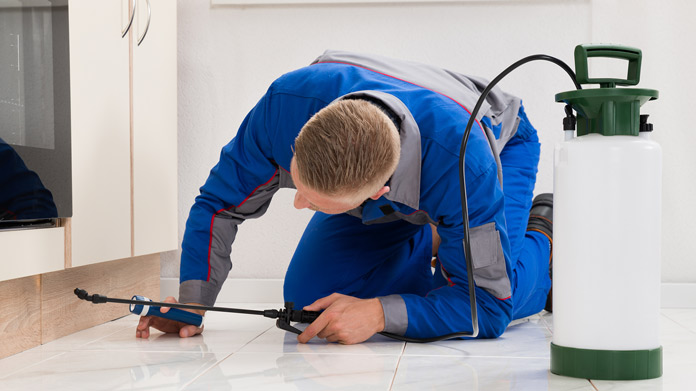Flea Control in Chicago: Expert Treatment for Flea Infestations
A Comprehensive Guide to the Various Kinds of Pest Control Techniques
With the myriad of pest control approaches readily available, it can be overwhelming to locate the most efficient solution for a certain pest issue. In this extensive overview, we will certainly explore these various kinds of parasite control techniques, supplying insights into their applications and advantages. By the end, you will certainly have a clearer understanding of which method may be the finest fit for your parasite control needs.
Chemical Insect Control Approaches

One typical type of chemical bug control is insecticides. Insecticides target specific parasites, such as insects, termites, or ants, and can be utilized both indoors and outdoors.
One more kind of chemical bug control is rodenticides. These are chemical compounds designed to manage populations of rodents, such as rats and computer mice.
Weed killers, also called herbicides, are another kind of chemical insect control technique. Herbicides are made to uniquely kill undesirable plants, called weeds, without creating injury to preferable plants. They are typically made use of in farming, landscaping, and horticulture to regulate the growth of undesirable plants.
While chemical pest control techniques can be highly efficient in eliminating bugs, it is essential to utilize them judiciously and follow safety and security guidelines. Overuse or misuse of chemical pesticides can have adverse influence on human health and wellness and the setting. It is essential to utilize these approaches sensibly and consider alternate pest control methods whenever feasible.
Organic Pest Control Methods
Biological parasite control techniques entail using living microorganisms or all-natural materials to take care of and regulate pest populations. Unlike chemical methods, which commonly rely upon synthetic chemicals, organic control methods utilize the natural enemies of pests to regulate their populations. This approach is considered even more ecologically pleasant and lasting, as it reduces using damaging chemicals and lessens the risk of pesticide resistance.
One extensively made use of biological bug control method is the introduction of natural predators or parasites. Ladybugs are presented to manage aphids, while certain wasp varieties are launched to target caterpillars. These killers and bloodsuckers feed upon bugs, decreasing their numbers and stopping invasions.
Another biological control approach is the usage of microorganisms. Particular bacteria, viruses, and fungis can be utilized to contaminate and kill particular pests. The bacterium Bacillus thuringiensis is typically used to regulate caterpillars, as it produces toxic substances that are deadly to these bugs.
Organic control approaches can also involve the use of pheromones or natural materials that disrupt the breeding patterns of parasites. By disrupting their reproduction, these techniques help to reduce pest populations gradually.
While organic bug control methods are normally effective, they may call for longer periods to accomplish desired results contrasted to chemical methods. In addition, careful factor to consider has to be provided to the option and release of all-natural adversaries to stop unintended harm to useful microorganisms or environments.
Physical Pest Control Techniques
To properly handle and manage pest populaces, alternative insect control approaches referred to as physical insect control techniques are utilized. These techniques entail making use of physical obstacles, traps, or devices to stop bugs from accessing or harming building. One usual physical pest control technique is making web use of screens or nets to maintain pests out of structures or yards. These screens are normally made from fine mesh material that allows for ventilation while avoiding pests from getting in. An additional physical pest control method is the installation of fences or walls to maintain bigger insects, such as deer or rabbits, out of gardens or agricultural fields. These obstacles literally obstruct the parasites' accessibility to the location, lowering the possibility for damage. Additionally, traps and devices can be utilized to catch or repel parasites. For example, sticky catches can be look at these guys positioned in locations where bugs are an issue, and the insects become stuck to the adhesive surface area. Ultrasonic gadgets can also be used to give off high-frequency sounds that are undesirable to bugs, triggering them to leave the area. Physical parasite control approaches are an ecologically pleasant choice to chemical pesticides, as they do not count on using damaging chemicals.
Natural Bug Control Methods
Natural pest control techniques offer a lasting and environment-friendly method to handling and eliminating bugs. These methods prioritize the usage of all-natural substances and organic representatives, minimizing the demand for chemical pesticides that can harm the environment and human wellness. Among the most usual natural bug control methods is biological control. This includes presenting natural predators or bloodsuckers to take advantage of or parasitize the parasites. Ladybugs are frequently introduced to yards to control aphid populaces. One more all-natural approach is the use of repellents obtained from plants. Specific plants, such as marigolds, lavender, and pepper mint, give off aromas that fend off bugs like insects, flies, and ants. In addition, social control practices can be employed to stop and handle parasite problems. This consists of correct sanitation, regular maintenance, and promoting biodiversity in the garden. For example, turning crops, eliminating garden debris, and encouraging natural predators can help avoid the buildup of insects. By embracing these natural insect control methods, individuals and neighborhoods can effectively manage pests while reducing the negative impacts on the setting and human health and wellness.
Integrated Insect Management (IPM)
Integrated Insect Monitoring (IPM) is a detailed and organized method to pest control that integrates numerous techniques and strategies to successfully take care of insects while lessening the use of chemical pesticides. IPM aims to preserve parasite populaces below the economic injury level by using a mix of cultural, biological, and chemical control techniques.
Social control techniques include changing the setting to make it much less favorable for insects. This can consist of techniques such as plant rotation, proper sanitation, and making use of resistant plant ranges. By creating unfavorable conditions for insects, cultural control techniques can explanation dramatically reduce bug populations.

Chemical control approaches are utilized as a last resort in IPM. They involve the targeted and wise use of pesticides to take care of parasite populations. Unlike conventional pest control approaches, IPM aims to minimize the usage of chemical pesticides by using different techniques.
Integrated Pest Monitoring (IPM) is a positive approach that concentrates on long-term insect monitoring rather than relying entirely on responsive measures. By combining numerous control techniques, IPM gives a much more sustainable and eco pleasant approach to pest control.
Verdict
In final thought, this article has provided a detailed review of the various types of pest control approaches. It reviewed chemical, organic, physical, and natural parasite control techniques, as well as the incorporated bug management technique. By comprehending these different methods, people can make educated choices on which insect control approach is most suitable for their details needs and preferences. Efficient insect control is crucial in preserving a healthy and pest-free atmosphere.